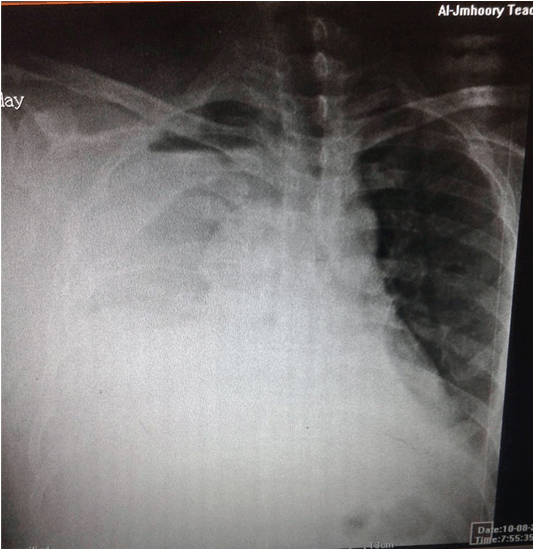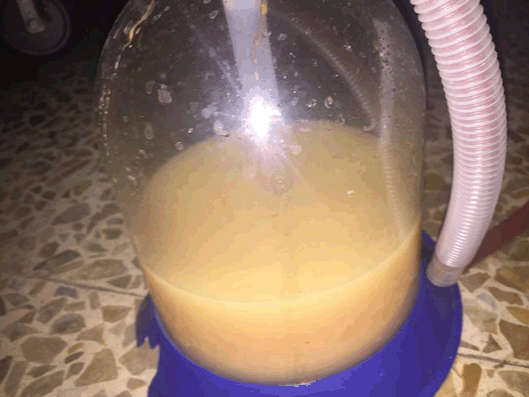 |
Case Report
Blunt chest trauma causing chylothorax: A case report with literature review
1 Mosul cardiac center, Mosul, Iraq
2 Faculty of Medical Sciences, School of Medicine, Department Cardiothoracic and Vascular Surgery, University of Sulaimani, Sulaimani, Kurdista, Iraq
3 Kscien organization, Hamdi Str. Azadi mall, Sulaimani, Kurdistan region, Iraq
Address correspondence to:
Fahmi H. Kakamad
Faculty of Medical Sciences, School of Medicine, Department Cardiothoracic and Vascular Surgery, University of Sulaimani, Sulaimani, Kurdistan,
Iraq
Message to Corresponding Author
Article ID: 100015C04OA2018
Access full text article on other devices

Access PDF of article on other devices

How to cite this article
Ahmed OF, Kakamad FH, Mohammed SH, Aziz MS. Blunt chest trauma causing chylothorax: A case report with literature review. Edorium J Cardiothorac Vasc Surg 2018;5:100015C04OA2018.ABSTRACT
Inrtoduction: Blunt trauma is regarded as an extremely rare cause of chylothorax. The aim of this study is to report a case of traumatic chylothorax with review management strategy.
Case Report: A 42-year-old male presented with blunt chest trauma complaining from severe back pain. On examination, he was stable, fully conscious with bilateral good air entry. Chest X-ray was normal. Computed tomography scan (CT Scan) showed fracture of D 10 vertebral body with multiple bilateral rib fracture. The patient was admitted to the intensive care unit (ICU) for monitoring. Second day, he developed shortness of breath new chest-X-ray showed near complete opacification of the right hemi thorax. Chest tube was inserted which drained 500 cc of blood stained thick fluid on entrance. For the next two days, the drain was continuous in amount of 1200 cc/day. The color changed into milky fluid. biochemical studies showed high level of triglyceride and lymphocyte. The patient was treated conservatively.
Conclusion: Although extremely rare, chylothorax may complicate blunt chest trauma. Diagnosis should be confirmed by laboratory testing before addressing management. Conservative therapy is a main method of management.
Keywords: Blunt chest trauma, Chylothorax, Triglyceride
INTRODUCTION
Chylothorax is a collection of milky fluid (chyle) between visceral and parietal plura due to leak from the thoracic duct. Bartolet is credited with the first description in 1633, while Quinke reported the first case in 1875 [1]. Chylothoraces are categorized as congenital, neoplastic, traumatic and miscellaneous [2]. Malignancy causing obstruction of the thoracic duct is regarded as the most prevalent cause of chylothorax [3]. Traumatic cause of chylothorax is usually iatrogenic, secondary to surgical intervention or percutaneous placement of catheters [4],[5]. Traumatic chylothorax (TC) usually results from penetrating wounds to the thoracic duct. Blunt trauma is regarded as an extremely rare cause of chylothorax. However, it should be considered in the differential diagnosis in those cases who sustain chest trauma and subsequently present with pleural collection since it may cause fatal complications [4],[5].
The aim of this study is to report a case of tension chylothorax following blunt chest trauma and review management strategy.
CASE REPORT
A 42-year-old male presented with blunt chest trauma after road traffic accident. He was complaining from severe back pain. On examination, he was fully conscious, bilateral good air entry, no neurological deficit and soft abdomen. Blood pressure: 130/75 mmHg, pulse rate 95 beats per minute, respiratory rate 18 cycles per minute. Chest X-ray was normal. Computed tomography scan (CT Scan) showed fracture of D10 vertebral body with multiple rib fracture (right 9th and 10th, left 9th,10th and 11th). The patient was admitted to the intensive care unit (ICU) for monitoring. Second day, he developed shortness of breath, increased gradually over the course of day, at night chest-x-ray showed near complete opacification of the right hemi thorax (Figure 1). Chest tube was inserted which drained 500 cc of blood stained thick fluid on entrance. For the next two days, the drain was continuous in amount of 1200 cc/day. The color changed into milky fluid (Figure 2). Two different samples of fluid sent for biochemical studies which showed high level of triglyceride and lymphocyte (496mg/dl, 90% respectively). Barium study was negative. The patient was kept on low fat diet, albumin vial, antibiotics (Metronidazole bottle 500 mg x 3, ceftriaxone 1 gm x 2) and octreotide three times daily. The amount of fluid for 2-8 post chest tube insertion was 800-100/day and stopped in 14th post insertion. Two months later, the patient was doing well.
DISCUSSION
Thoracic duct disruption is a rare but serious complication of chest trauma. Blunt trauma may cause TC through one of the several mechanism including: (1) hyperextension of the spine; (2) direct injury as a consequence of vertebral fracture; or (3) direct cut by the diaphragmatic crura [6],[7],[8]. In the current case, there was D1 vertebral fracture. The pleural fluid should be rich in proteins and lipids, but it does not always appear as typical milky-white because it might mix with other components. Fifty percent of patients with chylothorax have yellow, bloody or green turbid fluid [3],[9],[10]. Symptoms of a chylothorax typically have a gradual onset. Often two to seven days after the insult, clinical evidences appear [11]. In this case, the symptoms started two days after trauma.
The typical milky color of the plural fluid could be observed in pseudochylothorax or in some cases of empyema. That is why always chemical analysis of the fluid is mandatory for the diagnosis [12],[13]. Thus we quantitatively measured triglyceride in the pleural fluid to confirm the diagnosis. Staats et al. in their study, determined triglyceride values for 142 effusions, in which they defined as chylous or non-chylous by the gold standard test (lipoprotein electrophoresis by Gaussian distribution techniques) they concluded that fluid with a triglyceride value of more than 110 mg/dL has 99% chance of being chylous and fluid with a triglyceride value less than 50 mg/dL has no more than a 5% chance of being chylous [5]. Chylothorax could be diagnosed through several methods. The definitive diagnosis is based on the presence of chylomicrons in the pleural sample [12].
The management of chylothorax depends on several factors including etiology, clinical picture and the amount of drainage. Generally conservative strategy is preferred which was found to be successful in 88% of the cases. Conservative therapy includes a combination of nothing by mouth (NPO), tube thoracostomy, mediumchain triglycerides, total peripheral nutrition (TPN) and observation. Patients may require aggressive nutritional support to correct electrolyte abnormalities, protein loss, immunosuppression and hypovolemia. Few authors recommend octreotide infusions as a way to decrease the output of chylous effusions [14],[15]. As the symptoms were severe, we added octreotide.
Naturally, Chyle is an irritating fluid which practically promotes pleurodesis and leads to spontaneous closure of the leak. The chest tube induces lung expansion which closes fistulae and improves the clinical status. Patients are kept NPO to diminish the chyle and give time to the duct to heal since lymph flow is about 14 mL/ hour in the fasting state and 100 mL/hour after eating[16]. Ideally conservative management is offered for two weeks and it can be extended to four weeks [17]. In general, surgical intervention gives better results than conservative management when the daily chyle leak exceeds 1 Lilter/ day for a period more than 5 days [17].
The main surgical option is ligation of the thoracic duct. This may be performed through video assisted thoracoscopic surgery (VATS) or open thoracotomy. Many authors prefer to ligate it at the level of the diaphragm as this has the advantage of controlling flow from all accessory ducts [18],[19]. Before the advent of thoracic duct ligation, the mortality rate from persistent chylothorax was greater than 50%, surgical intervention decreased the mortality rate of persistent chylothorax to less than 10%. Newer modalities are under researches. Recent studies have shown good success rate with percutaneous embolization and robotic surgery [20],[21],[22],[23].
CONCLUSION
Although extremely rare, chylothorax may complicate blunt chest trauma. Diagnosis should be confirmed by laboratory testing before addressing management. Patients with these conditions are successfully managed with conservative treatment including decompression of chest and correction of physiological derangement. If there is no improvement after two weeks, surgical options should be considered.
REFERENCE
1.
Jahsman WE. Chylothorax; brief review of literature; report of three non-traumatic cases. Ann Intern Med 1944;21(4):669–78. [CrossRef]

2.
3.
McWilliams A, Gabbay E. Chylothorax occurring 23 years post-irradiation: Literature review and management strategies. Respirology 2000 Sep;5(3):301–3. [CrossRef]
[Pubmed]

4.
Seitelman E, Arellano JJ, Takabe K, Barrett L, Faust G, Angus LG. Chylothorax after blunt trauma. J Thorac Dis 2012 Jun 1;4(3):327–30. [CrossRef]
[Pubmed]

5.
Pillay TG, Singh B. A review of traumatic chylothorax. Injury 2016 Mar;47(3):545–50. [CrossRef]
[Pubmed]

6.
Idris K, Sebastian M, Hefny AF, Khan NH, Abu-Zidan FM. Blunt traumatic tension chylothorax: Case report and mini-review of the literature. World J Clin Cases 2016 Nov 16;4(11):380–4. [CrossRef]
[Pubmed]

7.
Guillem P, Billeret V, Houcke ML, Triboulet JP. Successful management of post-esophagectomy chylothorax/chyloperitoneum by etilefrine. Dis Esophagus 1999;12(2):155–6.
[Pubmed]

8.
Cerfolio RJ, Allen MS, Deschamps C, Trastek VF, Pairolero PC. Postoperative chylothorax. J Thorac Cardiovasc Surg 1996 Nov;112(5):1361–5. [CrossRef]
[Pubmed]

9.
McCormick J 3rd, Henderson SO. Blunt trauma-induced bilateral chylothorax. Am J Emerg Med 1999 May;17(3):302–4. [CrossRef]
[Pubmed]

10.
Kumar S, Mishra B, Krishna A, et al. Nonoperative management of traumatic chylothorax. Indian J Surg 2013 Jun;75(Suppl 1):465–8. [CrossRef]
[Pubmed]

11.
Ikonomidis JS, Boulanger BR, Brenneman FD. Chylothorax after blunt chest trauma: A report of 2 cases. Can J Surg 1997 Apr;40(2):135–8.
[Pubmed]

12.
Grant PW, Brown SW. Traumatic chylothorax: A case report. Aust N Z J Surg 1991 Oct;61(10):798–800.
[Pubmed]

13.
Staats BA, Ellefson RD, Budahn LL, Dines DE, Prakash UB, Offord K. The lipoprotein profile of chylous and nonchylous pleural effusions. Mayo Clin Proc 1980 Nov;55(11):700–4.
[Pubmed]

14.
Demos NJ, Kozel J, Scerbo JE. Somatostatin in the treatment of chylothorax. Chest 2001 Mar;119(3):964–6. [CrossRef]
[Pubmed]

15.
Bac DJ, Van Hagen PM, Postema PT, ten Bokum AM, Zondervan PE, van Blankenstein M. Octreotide for protein-losing enteropathy with intestinal lymphangiectasia. The Lancet 1995 Jun 24;345(8965):1639. [CrossRef]
[Pubmed]

16.
Johnstone DW, Feins RH. Feins RH. Chylothorax. Chest Surg Clin N Am 1994 Aug;4(3):617–28.
[Pubmed]

17.
Dugue L, Sauvanet A, Farges O, Goharin A, Le Mee J, Belghiti J. Output of chyle as an indicator of treatment for chylothorax complicating oesophagectomy. Br J Surg 1998 Aug;85(8):1147–9. [CrossRef]
[Pubmed]

18.
Patterson GA, Todd TR, Delarue NC, Ilves R, Pearson FG, Cooper JD. Supradiaphragmatic ligation of the thoracic duct in intractable chylous fistula. Ann Thorac Surg 1981 Jul;32(1):44–9.
[Pubmed]

19.
MShackford SR, Dunne CE, Karmy-Jones R, et al. The evolution of care improves outcome in blunt thoracic aortic injury: A Western Trauma Association multicenter study. J Trauma Acute Care Surg 2017 Dec;83(6):1006–13. [CrossRef]
[Pubmed]

20.
Barnidge M, Vea R, Rau B, Chu Q, Behm W, D'Agostino H. Management of postoperative chylothorax utilizing percutaneous CT-guided drainage. La State Med Soc 2008 Jul-Aug;160(4):221–4.
[Pubmed]

21.
Litherland B, Given M, Lyon S. ercutaneous radiological management of high-output chylothorax with CT-guided needle disruption. J Med Imaging Radiat Oncol 2008 Apr;52(2):164–7. [CrossRef]
[Pubmed]

22.
Patel N, Lewandowski RJ, Bove M, Nemcek AA Jr, Salem R. Thoracic duct embolization: A new treatment for massive leak after neck dissection. Laryngoscope 2008 Apr;118(4):680–3. [CrossRef]
[Pubmed]

23.
Thompson KJ, Kernstine KH, Grannis FW Jr, Mojica P, Falabella A. Treatment of chylothorax by robotic thoracic duct ligation. Ann Thorac Surg 2008 Jan;85(1):334–6 [CrossRef]
[Pubmed]

SUPPORTING INFORMATION
Author Contributions
Okba F. Ahmed - Substantial contributions to conception and design, Acquisition of data, Analysis of data, Interpretation of data, Drafting the article, Revising it critically for important intellectual content, Final approval of the version to be published
Fahmi H. Kakamad - Substantial contributions to conception and design, Acquisition of data, Analysis of data, Interpretation of data, Drafting the article, Revising it critically for important intellectual content, Final approval of the version to be published
Shvan H. Mohammed - Substantial contributions to conception and design, Acquisition of data, Analysis of data, Interpretation of data, Drafting the article, Revising it critically for important intellectual content, Final approval of the version to be published
Masrur S Aziz - Substantial contributions to conception and design, Acquisition of data, Analysis of data, Interpretation of data, Drafting the article, Revising it critically for important intellectual content, Final approval of the version to be published
Guarantor of SubmissionThe corresponding author is the guarantor of submission.
Source of SupportNone
Consent StatementWritten informed consent was obtained from the patient for publication of this case report.
Data AvailabilityAll relevant data are within the paper and its Supporting Information files.
Conflict of InterestAuthors declare no conflict of interest.
Copyright© 2018 Okba F. Ahmed et al. This article is distributed under the terms of Creative Commons Attribution License which permits unrestricted use, distribution and reproduction in any medium provided the original author(s) and original publisher are properly credited. Please see the copyright policy on the journal website for more information.





